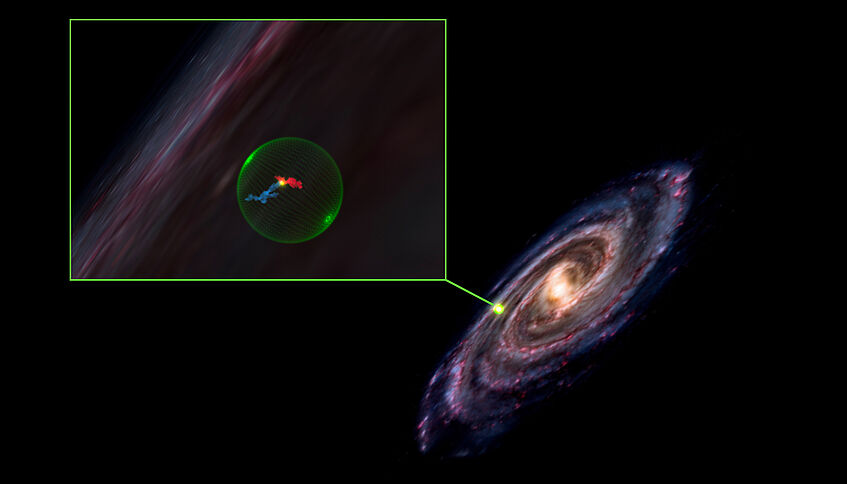Gigantic cavity in space discovered
Gigantic cavity in space discovered
22.09.2021
Astronomers – among them João Alves from the Department of Astrophysis at the University of Vienna – have discovered a humongous cavity in space while mapping interstellar dust. The sphere-shaped phenomenon may explain how supernovae lead to star formation.
Astronomers who were creating 3D maps of the shapes and sizes of nearby molecular clouds have discovered a gigantic cavity in space.
The sphere-shaped void, described in the Astrophysical Journal Letters, spans about 150 parsecs — nearly 500 light years — and is located on the sky among the constellations Perseus and Taurus. The research team, which is based on a collaboration between the Center for Astrophysics | Harvard & Smithsonian and the Department of Astrophysics of the University of Vienna believes the cavity was formed by ancient supernovae that went off some 10 million years ago.

Astronomers have discovered that two famous molecular clouds within the Milky Way galaxy, Perseus (red) and Taurus (blue), lie on the rim of a huge interstellar bubble, shedding new light on the process of star formation. (C) Jasen Lux Chambers/Center for Astrophysics | Harvard & Smithsonian
The mysterious cavity is surrounded by the Perseus and Taurus molecular clouds — “two regions in space where stars form”, explains João Alves from the Department of Astrophysis at the University of Vienna, one of the co-authors of the paper
Hundreds of stars at the surface of the giant bubble
“Hundreds of stars are forming or exist already at the surface of this giant bubble,” says Shmuel Bialy, a postdoctoral researcher at the Institute for Theory and Computation (ITC) at the Center for Astrophysics (CfA) who led the study. “We have two theories—either one supernova went off at the core of this bubble and pushed gas outward to form the bubble, or a series of supernovae occurring over millions of years created it over time.”
The finding suggests that the Perseus and Taurus molecular clouds are not independent structures in space. But rather, they formed together from the very same supernova shockwave. “This demonstrates that when a star dies, its supernova generates a chain of events that may ultimately lead to the birth of new stars,” Bialy explains.
The finding suggests that the Perseus and Taurus molecular clouds are not independent structures in space. But rather, they formed together from the very same supernova shockwave. “This demonstrates that when a star dies, its supernova generates a chain of events that may ultimately lead to the birth of new stars,” Bialy explains.
Mapping Stellar Nurseries
The 3D map of the bubble and surrounding clouds were created using new data from Gaia, a space-based observatory launched by the European Space Agency (ESA).
Descriptions of exactly how 3D maps of the Perseus and Taurus molecular clouds and other nearby clouds were created appear in a separate study published today in the Astrophysical Journal (ApJ).

The location of the cavity is depicted on the right. A zoomed in view of the cavity (left) shows the Perseus and Taurus molecular clouds in red and blue. Though the clouds appear to touch in this 2D view, new 3D images of the clouds show they lie at very different distances on the surface of the cavity shown in green. Image produced in glue using WorldWide Telescope's Milky Way data-driven cartoon (produced by Robert Hurt). (C) Alyssa Goodman/Center for Astrophysics | Harvard & Smithsonian.
The maps represent the first-time molecular clouds have been charted in 3D. Previous images of the clouds were constrained to two dimensions. “We’ve been able to see these clouds for decades, but we never knew their true shape, depth or thickness. We also were unsure how far away the clouds were,” says Catherine Zucker, a postdoctoral researcher at the CfA who led the ApJ study. “Now we know where they lie with only 1 percent uncertainty, allowing us to discern this void between them.”
Video
Why map clouds?
But why map clouds in the first place? “There are many different theories for how gas rearranges itself to form stars,” Zucker explains. “Astronomers have tested these theoretical ideas using simulations in the past, but this is the first time we can use real — not simulated — 3D views to compare theory to observation, and evaluate which theories work best.”

João Alves, University of Vienna. (C) Barbara Mair, University of Vienna
„Very exiting time for astronomers“
“Recently, we discovered the largest coherent gas structure in the Milky Way”, says João Alves from the University of Vienna, “and both the Perseus and Taurus clouds are small part of this large structure. This 3D result tells us about the complex fine structure of the Wave, and how it fragments into stellar nurseries first, stars, and planets. 3D changes everything, it’s a very exciting time for astronomers”.
The Perseus-Taurus Supershell in Augmented Reality
About the papers
- Additional co-authors on the Astrophysical Journal Letters-Article are: Catherine Zucker, Alyssa Goodman, Michael Foley and Vadim Semenov of the Center for Astrophysics; João Alves of the University of Vienna; Robert Benjamin of the University of Wisconsin-Whitewater; and Reimar Leike and Torsten Ensslin of the Max Planck Institute for Astrophysics.
- Co-authors on the Astrophysical Journal-Study are: Alyssa Goodman, Shmuel Bialy, Eric Koch, Joshua Speagle, Michael Foley and Douglas Finkbeiner of the Center for Astrophysics; João Alves of the University of Vienna; Reimar Leike, Torsten Ensslin and Gordian Edenhofer of the Max Planck Institute for Astrophysics; and Joshua Peek of the Space Telescope Science Institute.
- The augmented reality figure was made possible thanks to a collaboration between the glue team, the American Astronomical Society and Delightex, a commercial software company. glue is funded by the National Science Foundation, NASA and the Moore Foundation.
